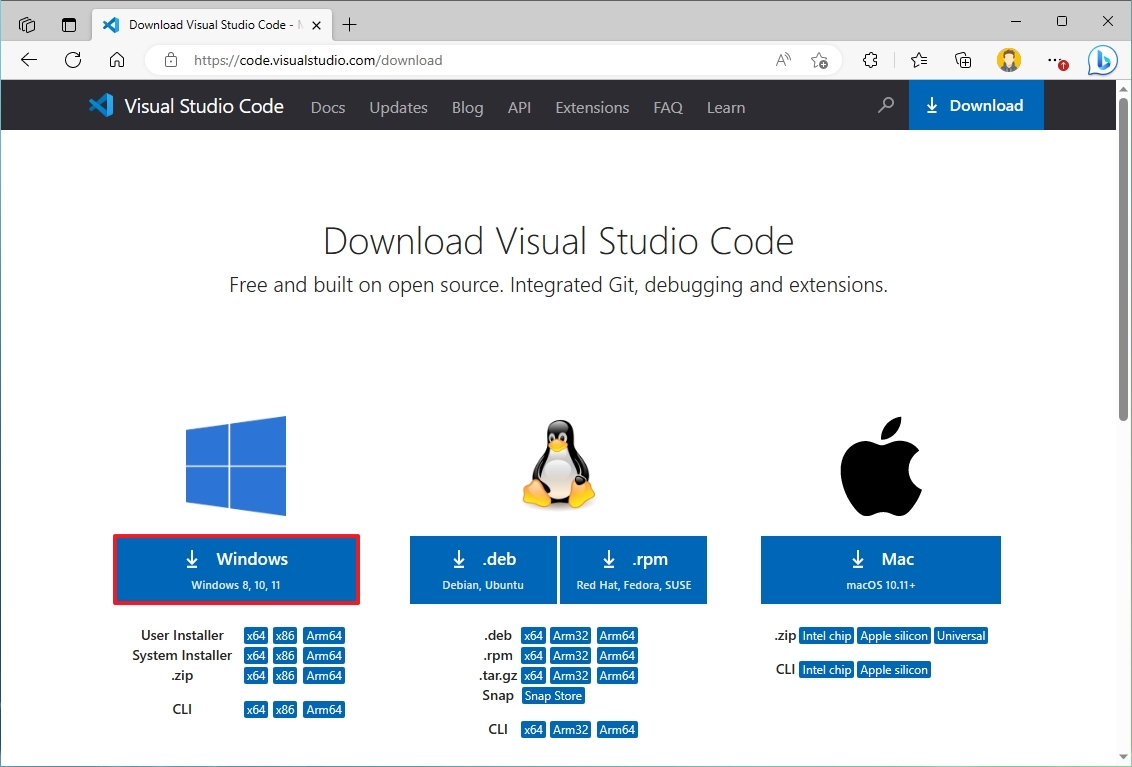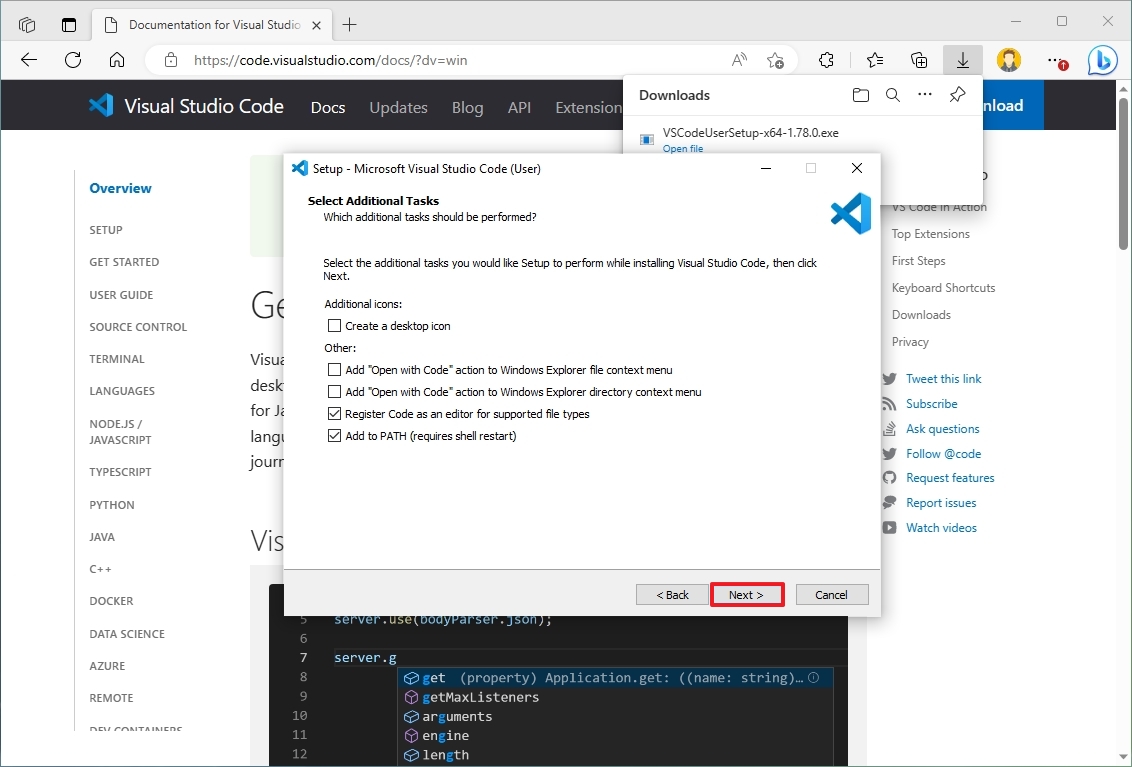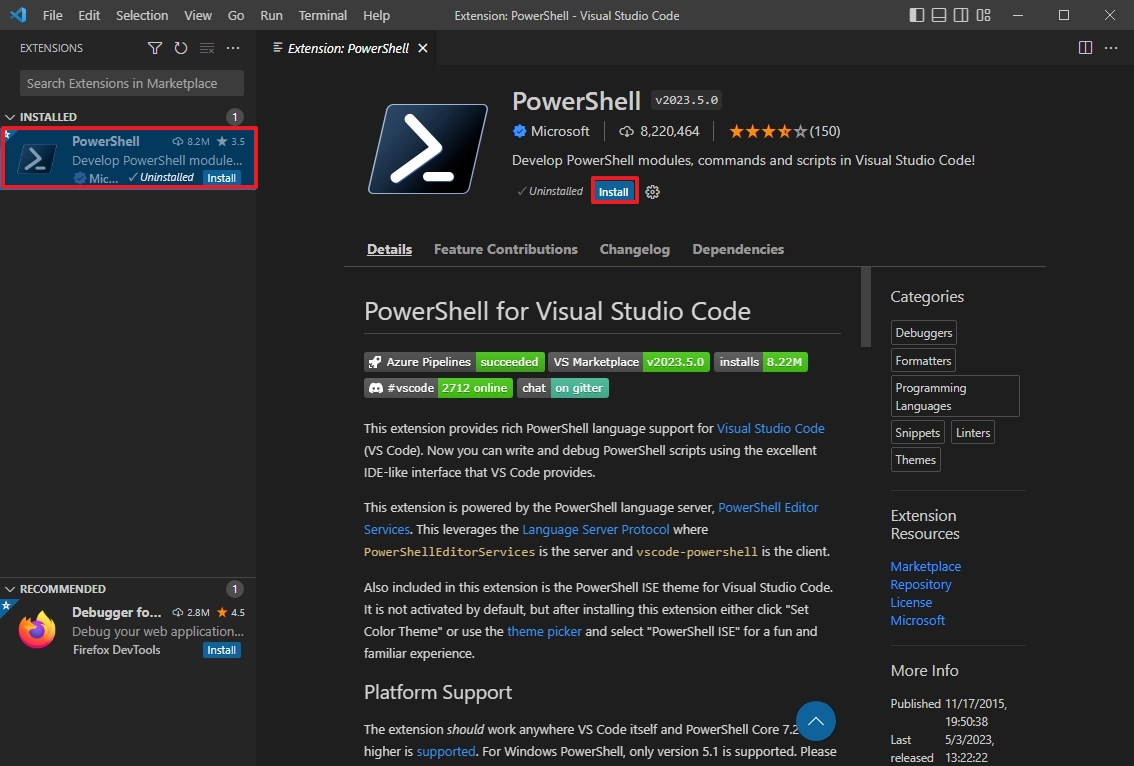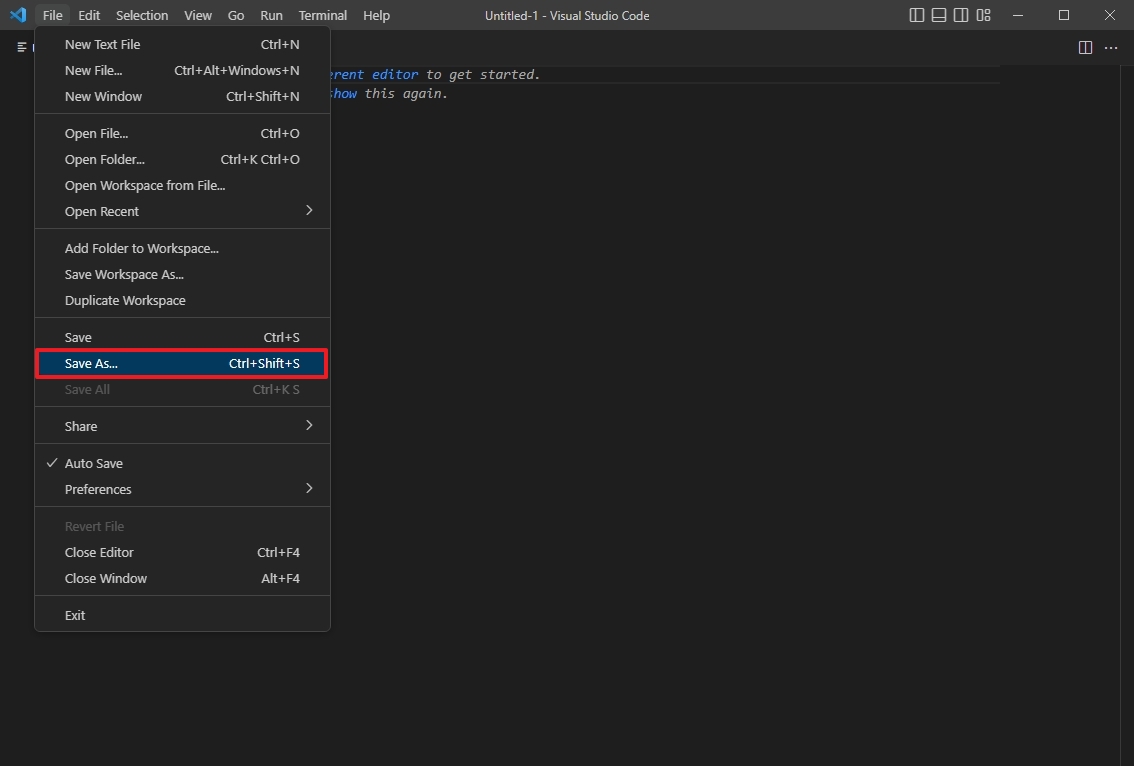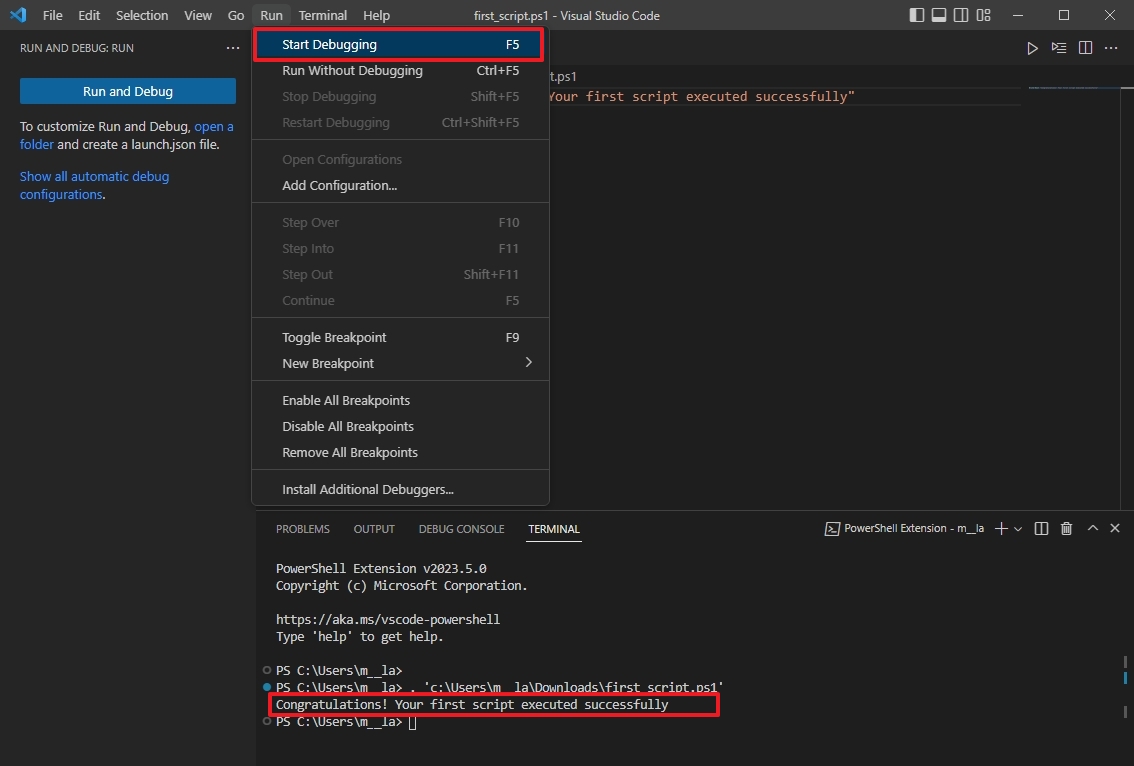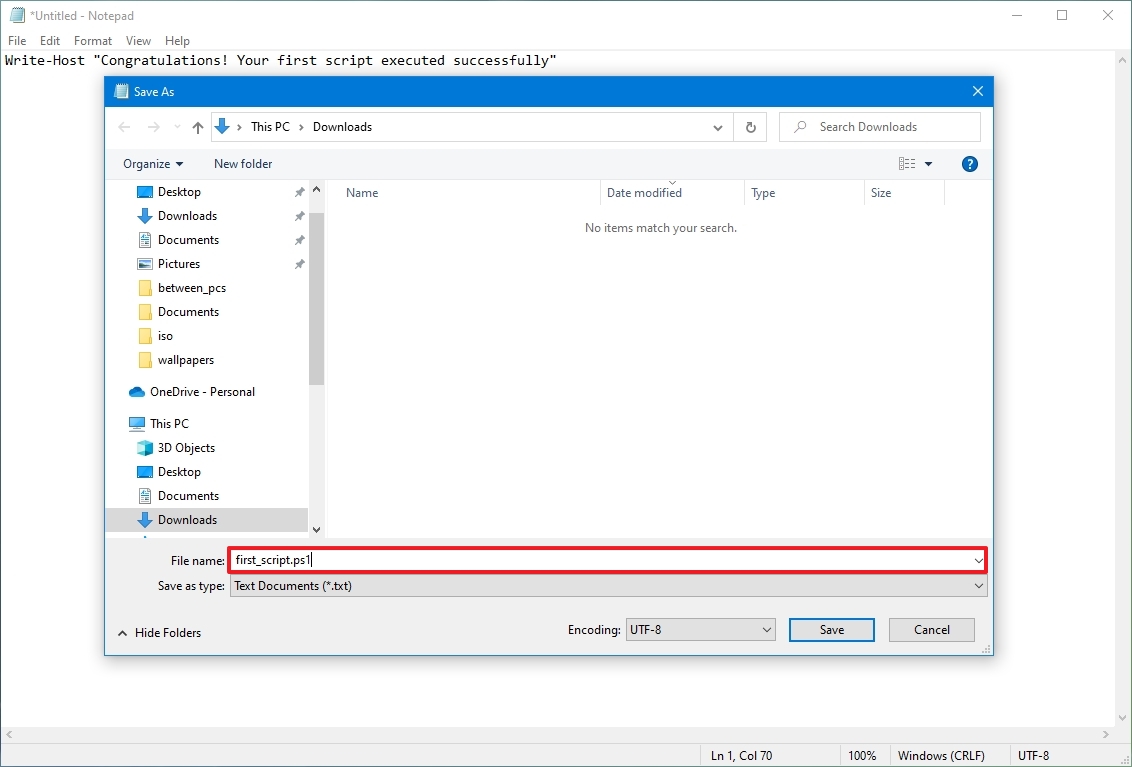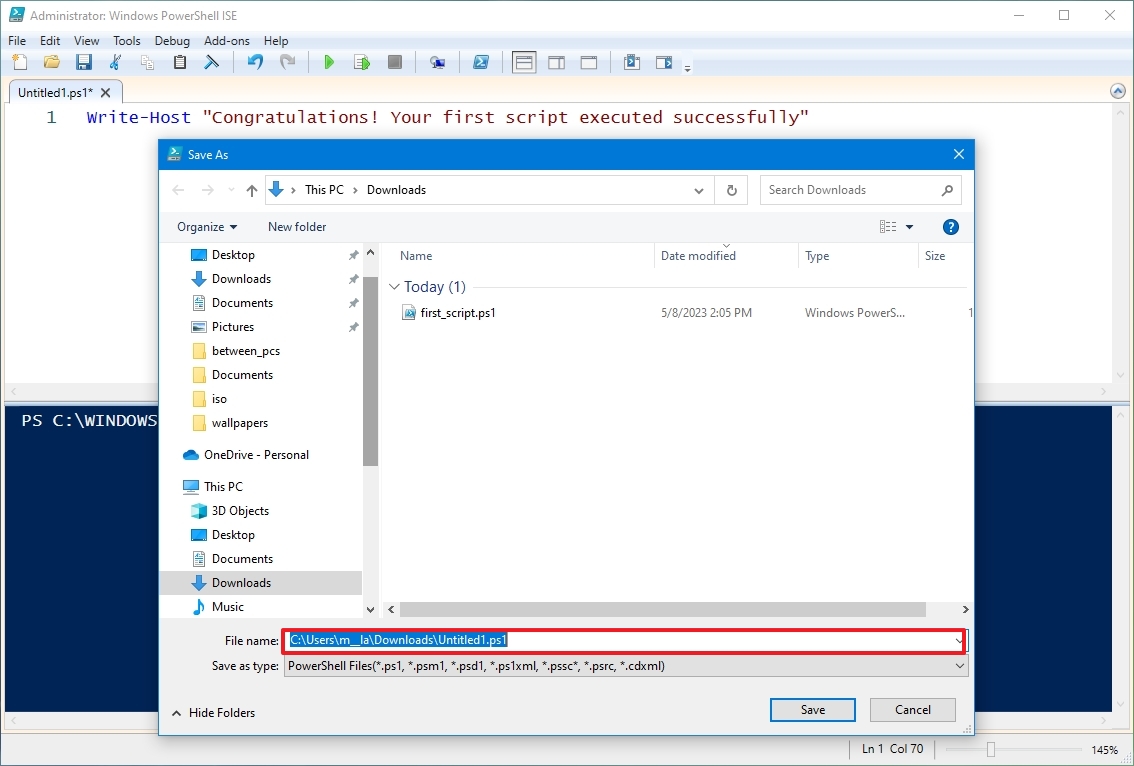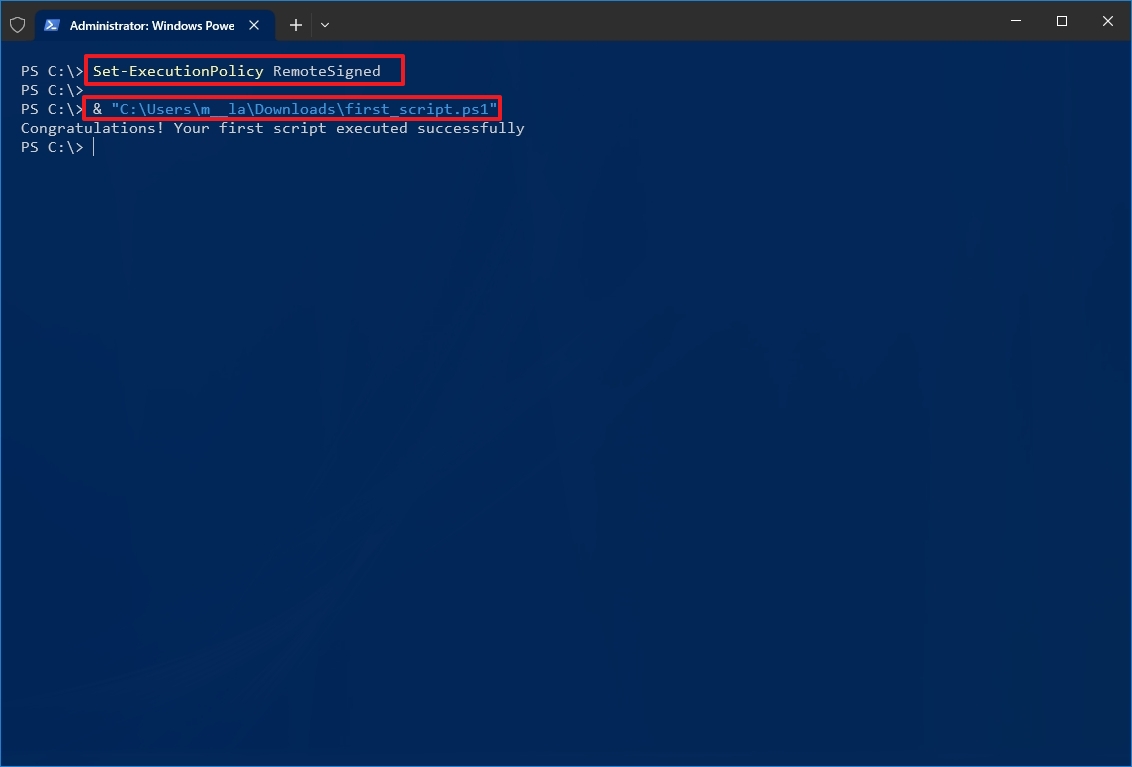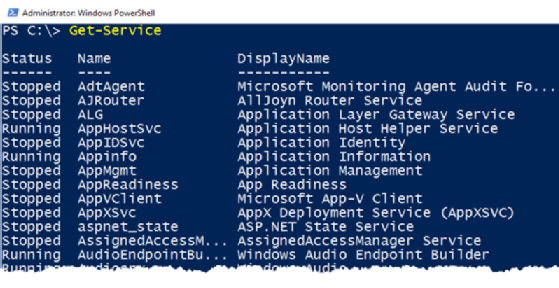
(Image credit: Future)
On Windows 10 (or 11), PowerShell is a command-line interface (CLI) that allows you to run commands and scripts to automate tasks and change settings on your computer, similar to Command Prompt. However, PowerShell is a more powerful CLI that offers a more extensive set of tools and more flexibility. In addition, unlike Command Prompt, PowerShell is available across platforms, including Windows, macOS, and Linux.
Regardless of the platform, a script is a collection of instructions written to a text file (using the particular «.ps1» extension) that PowerShell understands and executes in sequence to run different actions.
The only problem is that the default security protocol prevents scripts from running on your device. This means that when double-clicking a «.ps1» file, Windows 10 won’t do anything, and if you try to run the script within PowerShell, you will see the «cannot be loaded because running scripts is disabled on this system» error message. However, running scripts on your computer is not impossible. You only need to enable the correct execution policy.
This how-to guide will walk you through the steps to write and run your first script file on PowerShell using Visual Studio Code, Notepad, and the PowerShell Integrated Scripting Environment (ISE) console, whether you use Windows 10 or the newer Windows 11.
How to create PowerShell script file on Windows 10
It’s possible to create PowerShell script files using any text editor or the legacy ISE application. However, the Visual Studio Code editor is the preferred option for writing scripts (whenever possible).
Create a script with VS Code
Visual Studio Code (VS Code) is a free and extensible cross-platform code editor to edit virtually any programming language. And when adding the PowerShell extension, you get an interactive scripting editing experience, which even comes with IntelliSense (code-completion) support.
You can still use PowerShell ISE, but Visual Studio Code with the PowerShell extension is meant to be the new default experience. Also, consider that the legacy experience won’t get any new features and doesn’t support PowerShell 7 or higher releases.
Install VS Code
To install Visual Basic Code on Windows 10 (or 11), use these steps:
- Open the Visual Studio Download page.
- Click the Windows button to download the installation file.
- Double-click the installer to begin the process.
- Select the «I accept the agreement» option.
- Click the Next button.
- Confirm additional tasks as necessary.
- Click the Next button again.
- Click the Install button.
- Click the Finish button.
Once you complete the steps, you can continue installing the PowerShell extension for VS Code.
Install PowerShell extension
To install the PowerShell extension on VS Code, use these steps:
- Open VS Code.
- Click the Extensions tab («Ctrl + Shift + X» keyboard shortcut) from the left pane.
- Search for PowerShell and select the top result.
- Click the Install button.
- Click the «Trust Workspace & Install» button.
After you complete the steps, you can start writing PowerShell scripts from Visual Studio Code.
Create PowerShell script with Visual Studio Code
To create a script with Visual Basic Code on Windows 10 (or 11), use these steps:
- Open VS Code.
- Click the File menu and select the «New Text File» option.
- Click the File menu and select the Save As option.
- In the «File name» field, specify a name for the file with the «.ps1» extension — for example, first_script.ps1.
- Click the Save button.
- Write a new or paste the script you want to run — for example, Write-Host «Congratulations! Your first script executed successfully»
- Quick note: The above script will output on the screen that says: «Congratulations! Your first script executed successfully.»
- (Optional) Open the Run menu, select the Start Debugging option from the command bar, or press the F5 key) to run the script.
- Click the File menu.
- Click the Save option.
Create PowerShell script with Notepad
To create a PowerShell script with Notepad, use these steps:
- Open Start.
- Search for Notepad, and click the top result to open the app.
- Write a new or paste your script in the text file — for example, Write-Host «Congratulations! Your first script executed successfully»
- Quick note: Although the Notepad app looks a little different on Windows 11, the instructions will also apply.
- Click the File menu.
- Select the Save As option.
- Confirm a descriptive name for the script — for example, first_script.ps1.
- Click the Save button.
Create PowerShell script with Integrated Scripting Environment
You can also use the built-in PowerShell ISE app to code your scripts on Windows 10 (or 11).
The Integrated Scripting Environment (ISE) is a complex tool, but you can get started using these easy steps:
- Open Start.
- Search for Windows PowerShell ISE, right-click the top result, and select the Run as administrator option.
- Click the File menu.
- Select the New option to create a new empty «.ps1» file.
- Write a new, or paste the script you want to run — for example, Write-Host «Congratulations! Your first script executed successfully»
- Click the File menu.
- Click the Save option.
- Type a name for the script — for example, first_script.ps1.
- Select the folder to save the script file.
- Click the Save button.
- (Optional) Click the Run button on the top-right side (or press the F5 key) to run the script.
Once you complete the steps using Notepad, Visual Studio Code, or PowerShell ISE, the script will be ready but fail using the default system settings. The reason is that the default PowerShell settings are configured to block the execution of any script. (The only exception is if you run the script’s contents within Visual Studio Code or PowerShell ISE.)
How to run PowerShell script file on Windows 10
Regardless of the version of Windows, you must change the execution policy to run a script with PowerShell.
To change the execution policy to run PowerShell scripts on Windows 10, use these steps:
- Open Start.
- Search for PowerShell, right-click the top result, and select the Run as administrator option.
- Type the following command to allow scripts to run and press Enter: Set-ExecutionPolicy RemoteSigned
- Type «A» and press Enter (if applicable).
- Type the following command to run the script and press Enter: & «C:\PATH\TO\SCRIPT\first_script.ps1»
In the above command, change «PATH\TO\SCRIPT» to the location of your script. For example, this command runs a script stored in the «Downloads» folder: & «C:\Users\username\Downloads\first_script.ps1»
After you complete the steps, the script will run, and if it was written correctly, you should see its output on the screen without issues.
PowerShell includes four execution policies that apply to Windows 10:
- Restricted — Prevents any script from running.
- RemoteSigned — Allows scripts created on the computer, but scripts created on another device won’t run unless they include a trusted publisher’s signature.
- AllSigned — All the scripts will run, but only if a trusted publisher has signed them.
- Unrestricted — Runs any script without any restrictions.
It’s recommended only to allow local scripts to run a script from a trusted source. If you don’t plan to run scripts regularly, it’s best to restore the default settings to block untrusted scripts using the same instructions outlined above, but in step 4, use the Set-ExecutionPolicy Restricted command.
More resources
For more helpful articles, coverage, and answers to common questions about Windows 10 and Windows 11, visit the following resources:
- Windows 11 on Windows Central — All you need to know
- Windows 10 on Windows Central — All you need to know
All the latest news, reviews, and guides for Windows and Xbox diehards.
Mauro Huculak is technical writer for WindowsCentral.com. His primary focus is to write comprehensive how-tos to help users get the most out of Windows 10 and its many related technologies. He has an IT background with professional certifications from Microsoft, Cisco, and CompTIA, and he’s a recognized member of the Microsoft MVP community.
In a manner similar to Command Prompt, Windows 10’s PowerShell allows you to execute commands and scripts to automate tasks and modify system settings. But PowerShell is a more capable command-line interface (CLI) that provides a wider range of tools and greater flexibility. PowerShell is additionally accessible on all operating systems, including Windows, Linux, and macOS, in contrast to Command Prompt.
Regardless of the platform, a script is a group of instructions written to a text file (using the unique “.ps1” extension) that PowerShell understands and executes in order to perform various actions.
The only issue is that scripts cannot be run on your computer due to the default security protocol. As a result, when you double-click a “.ps1” file in Windows 10, nothing happens, and you’ll get the error message “Cannot be loaded because running scripts is disabled on this system” if you try to run the script in PowerShell. But it’s not impossible to run scripts on your computer. Only the proper execution policy needs to be enabled.
How do I write a CMD script?
Opening Notepad with a Script Type CMD in the Windows Start menu and hit Enter to launch CMD.exe. Enter “cd” to change the directory from your current username folder to the base directory. Start Notepad by typing “c:windowssystem32” and pressing Enter. exe.
You probably have some idea of the powerful capabilities of Windows’ Command Line, or CMD, interface if you’ve ever used it. Even more can be accomplished more quickly by writing your own CMD scripts.
A CMD script performs the same function as entering commands directly into the CMD window. You can create a script that you can then activate whenever you want it to run if you want to perform a regular action, like telling Windows to turn off your computer after an hour.
In the early days of personal computing, a command-line interface was used to perform almost all tasks. A program’s name had to be entered into the command line in order to be opened. The majority of actions can now be carried out by simply clicking or touching an icon on your screen. The CMD utility in Windows, however, continues to accept typed commands. The CMD window allows you to enter commands to launch programs, add or modify account permissions, backup files, and obtain system information.
Does Microsoft offer a script editor?
You can add Microsoft Visual Basic Scripting Edition (VBScript) procedures that react to events produced by objects or form controls using the Microsoft Script Editor. You are running in developer mode if you can see the Developer tab.
For access to the newest features, security updates, and technical support, upgrade to Microsoft Edge.
You can add VBScript procedures—Microsoft Visual Basic Scripting Edition—that react to events produced by objects or form controls using the Microsoft Script Editor.
You are operating in developer mode if the Developer tab is visible. To run in developer mode in Outlook otherwise, see Run in Developer Mode in Outlook.
I need to know how to create a shell script in Windows
Open the terminal to begin writing and running a script. Navigate to the directory where your script will be created. Dot-sh file creation is required. Use an editor to enter the script in the file. Make the script executable by using the command chmod x. Run the script.
If your script is located in another directory, you must specify the path to it in the final step.
Here, we’ll create a basic Hello World program.
Create a basic script first using any editor or echo. The chmod x command will then be used to make it executable. You must type the shell script path in order to locate the script.
Is CMD suitable for coding?
Our C programs are typically compiled using a compiler with a graphical user interface. You could also use cmd to accomplish this. To run our program without using a GUI compiler, we must follow a set of instructions at the command prompt.
Our C program is typically compiled using a compiler with a graphical user interface. You could also use cmd to accomplish this. We must follow a set of instructions at the command prompt in order to run our program without a GUI compiler. In this article, we’ll learn how to compile a C program at the command prompt.
Let’s begin this article on command-prompt C program compilation now.
Use the ‘gcc -v’ command to see if you have a compiler set up. If this is not the case, you must download and install the GCC compiler. To open the command prompt, simply type cmd into your Windows computer.
Scripts can be executed on Windows
A script can be run by double-clicking it in Windows Explorer or on the desktop to use the default engine. Enter the script name after clicking Start, Run. Just type the script name into the command line on Windows NT and Windows 2000 only.
You can run scripts from Windows using the Windows Script Host. WScript. For configuring script properties, exe offers a Windows-based dialog box. WScript is used. You can execute scripts in Windows using the following methods: You run the scripts in the same way whether you use WScript or CScript. The only difference is in the output: WScript produces windowed output, whereas CScript sends its output to the command window in which it was initiated.
WScript is set as the default host during initial installation. Enter the following command-line parameters to convert it to CScript:
In Windows Explorer or on the desktop, double-click the script.
Windows uses what scripting language?
By default, VBScript is the main scripting language. Any scripting language for which you have a script engine is acceptable to use as the main scripting language. On a page-by-page basis or for all pages in an ASP application, you can specify the primary scripting language.
To benefit from the most recent features, security updates, and technical support, switch to Microsoft Edge.
Programs written in complex, large-scale programming languages like Visual Basic, C, and Java have low-level access to computer resources. However, scripts—limited-capability programs created using scripting languages—are used to run web site functions on a web server or browser. Unlike more complex programming languages, scripting languages are interpreted, meaning that command interpreters—an intermediary program—sequentially carry out each instruction statement. Although interpretation decreases the effectiveness of execution, scripting languages are simple to learn and offer robust functionality. Scripts can be used to implement COM components that encapsulate complex business logic or to format content in HTML pages.
Web developers can use a variety of scripting languages with Active Server Pages to create scripts that run on the server. A single ASP file can actually contain code written in multiple scripting languages. Additionally, because scripts are read and executed on the server, the browser that requests the.asp file does not need to support scripting.
In what locations on my computer can I write scripts?
Simply open Notepad to get started. The script should be copied from your browser and pasted into Notepad. Save the script with a.vbs extension, such as.
People used to walk from one place to another a long time ago, even before any of the Scripting Guys were born. They didn’t do it for exercise or fun; rather, they had to get somewhere. Those who were fortunate enough to have other modes of transportation, such as horses, camels, elephants, or whatever the local pack animal happened to be, could travel a little more quickly. (And to those of you who continue to rely on any of the aforementioned methods of transportation as your main means of transportation, we’ll keep you in mind the next time we get caught in traffic.er.
The horseless carriage then appeared. There was much laughter. They remarked things like, “It’s just a fad,” and “Why would I ever want one of those?” and even, “That looks too dangerous. Then there were the incredibly few visionaries who said, “Wow, cool. I want to try one of those.” These last two people were the ones who understood not only how much fun a car could be but also how it could one day save them hours, if not days, of time traveling from place to place.
Some of the same responses to scripting that those people had to cars all those years ago are being experienced by people today. Why would I want to script? ” “Scripting is only for those zealots who don’t want to operate their systems the way everyone else does. However, if you want to try scripting, you simply need to be the kind of person who enjoys time savings; you don’t need to be imaginative or daring. (Those who find it enjoyable are still the devotees. Scripts can not only expedite the process of doing your work but also make it simpler. They’re also not too difficult to operate once you understand the fundamental traffic laws. (Traffic jams are also uncommon.)
What is a “.bat” file, and how do I write one?
Open a text document, such as a WordPad or Notepad document, and then follow these steps to create a Windows batch file. Your commands should be added in the following order: @echo (off), title (the title of your batch script), echo (the first line), and pause. Save your document with the BAT file extension, such as test.bat.
Once you know how, making a batch file to automate routine tasks is simple.
The computer handyman’s method of operation is batch files. They can automate routine tasks, cut down on the amount of time needed to complete a task, and simplify complicated procedures so that anyone can carry them out.
Learn how to create a basic batch file in this article. You’ll discover the fundamentals of batch files’ capabilities as well as how to create your own. I’ll also give you access to more materials so you can learn how to create batch (BAT) files.
Bash scripts can be executed on Windows
It should be noted that bash runs natively on Windows 10 as opposed to using emulators like “Cygwin” for Windows, which allowed GNU tools to run on an unsupported Windows environment. Additionally, the 64-bit edition of Windows 10 is the only one that supports the Linux subsystem.
Because of its popularity among programmers and the ease with which it can be used, Bash is one of the best-known features of Linux distributions. The command-line interface (cmd) of the Windows operating system On the other hand, exe lacked a number of the features that its Linux counterpart had.
Therefore, Microsoft added a number of features, including bash, to the Windows 10 OS in their Anniversary Update. The following actions must be taken in order to install and use it on Windows 10:
It should be noted that bash runs natively on Windows 10 as opposed to using emulators like “Cygwin” for Windows, which allowed GNU tools to run on an unsupported Windows environment. The Linux subsystem for Windows 10 is also restricted to the 64-bit edition of the operating system.
What kind of programming language are BAT files written in?
Batch files are also known as scripts or bat files. Not a high-level language like C but a straightforwardly interpreted scripting language, the language is known as batch script.
I’m guessing that C is the actual language used when one of these programs is running on Windows; I apologize if this is in the wrong section.
A DOS/Windows shell script called a “.bat” file is run by the DOS/Windows command interpreter. Batch files are what are created when a batch script is saved to a.bat file.
Simple batch script is the language. It is an easily interpreted scripting language, not a high-level language like C.
What programming language did Bill Gates use to create Windows?
Altair BASIC was developed by Bill Gates, Paul Allen, and Monte Davidoff for Micro-Soft. Its initial release was 2.0 (4K and 8K editions) on July 1, 1975, and its stable release was 5.0 on July 14, 1978.
Altair BASIC was created using assembly language, as seen on this title page.
The MITS Altair 8800 and later S-100 bus computers supported the BASIC programming language using the defunct Altair BASIC interpreter. It was Microsoft’s first product (as Micro-Soft), distributed by MITS pursuant to a contract. Microsoft’s line of BASIC products was launched with Altair BASIC.
When Bill Gates and Paul Allen read about the Altair in the January 1975 issue of Popular Electronics, they realized that computer prices would soon fall to the point where selling software for them would be a lucrative endeavor. (7) Gates reasoned that by including a BASIC interpreter in the new computer, hobbyists would find it more appealing. Ed Roberts, the founder of MITS, was contacted and asked if he would be interested in seeing a demonstration of the interpreter that they were creating. This was done in accordance with the dubious engineering industry practice of launching a trial balloon, which is an announcement of an unrealized product to gauge interest. In March 1975, Roberts agreed to meet with them for a demonstration.
What language does Windows use in place of Bash?
The majority of Windows operating systems come with PowerShell as their command shell and accompanying scripting language. 2. The majority of Linux operating systems use the command shell and scripting language bash.
- By utilizing their respective configuration management tools, PowerShell and Bash shell both offer a single intelligent command line interface (CLI).
- Bash and PowerShell are comparable. In general, PowerShell commands like “rm,” “ls,” and “cp” can be used in bash.
- Both the shell and other programs can be started using commands for managing files and navigating directories.
The three scripting languages are as follows:
Examples of scripting languages include Ruby, Python, and JavaScript. Although all programming languages are scripting languages, not all programming languages are scripting languages. Fundamentally, scripting languages are a set of instructions that can be run directly without having to first be compiled.
Which language is CMD coded in?
Actually, CMD is a form of shell scripting, much like bash, sh, or csh. It is helpful for automating tasks that involve using the command line to call already-existing programs.
- Does a programming language have anything to do with command prompts?
- CMD is not a programming language, so no. Run programs written in programming languages using CMD.
- Actually, CMD uses batch programming. You can use Notepad to create a batch file and save it with the “.bat” extension.
A.bat file Is it a script?
A batch file is a script file that contains commands that will be carried out sequentially. It assists in automating repetitive tasks without the need for user input or intervention.
A batch file is a script file that contains commands that will be carried out sequentially. Without user input or intervention, it assists in automating repetitive tasks. Batch files are frequently used for loading programs, running multiple processes, or carrying out repeated tasks sequentially in the system.
A text file created in Notepad or another text editor is referred to as a batch file and is also known as a batch job. An organized set of commands is bundled or packaged into a batch file and stored in serial order. These commands would need to be entered one at a time from the keyboard into the system without a batch file.
When a user has a repetitive requirement, a batch file is typically created for the command sequences. An interpreter for the command line uses the file as input and runs the commands in the specified sequence. A batch file eliminates the need to retype commands, saving the user time and reducing errors. Simplifying complicated processes is also beneficial.
In Windows, the batch file is a file that stores commands in a serial order. The command line interpreter takes the file as an input and executes in the same order. A batch file is simply a text file saved with the .bat file extension. It can be written using Notepad or any other text editor. A simple batch file will be:
// When echo is turned off, the command prompt doesn't appear in the Command Prompt window. ECHO OFF // The following command writes GeeksforGeeks to the console. ECHO GeeksforGeeks // The following command suspends the processing of a batch program and displays the prompt. PAUSE
After saving it with a .bat extension. Double click it to run the file. It prints shows:
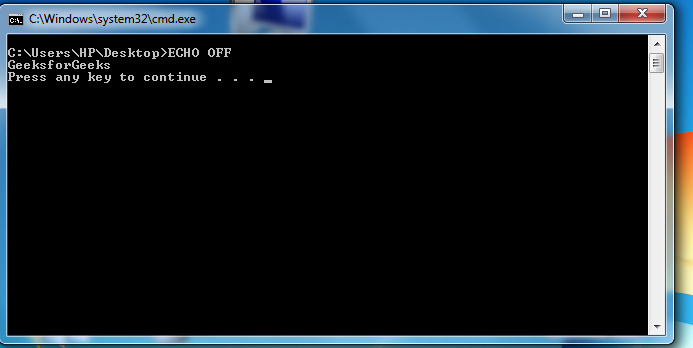
In the above script, ECHO off cleans up the console by hiding the commands from being printed at the prompt, ECHO prints the text “GeeksforGeeks” to the screen, and then waits for the user to press a key so the program can be ceased. Some basic commands of batch file:
- ECHO – Prints out the input string. It can be ON or OFF, for ECHO to turn the echoing feature on or off. If ECHO is ON, the command prompt will display the command it is executing.
- CLS – Clears the command prompt screen.
- TITLE – Changes the title text displayed on top of prompt window.
- EXIT – To exit the Command Prompt.
- PAUSE – Used to stop the execution of a Windows batch file.
- :: – Add a comment in the batch file.
- COPY – Copy a file or files.
Types of “batch” files in Windows:
- INI (*.ini) – Initialization file. These set the default variables in the system and programs.
- CFG (*.cfg) – These are the configuration files.
- SYS (*.sys) – System files, can sometimes be edited, mostly compiled machine code in new versions.
- COM (*.com) – Command files. These are the executable files for all the DOS commands. In early versions there was a separate file for each command. Now, most are inside COMMAND.COM.
- CMD (*.cmd) – These were the batch files used in NT operating systems.
Lets take another example, Suppose we need to list down all the files/directory names inside a particular directory and save it to a text file, so batch script for it will be,
@ECHO OFF // A comment line can be added to the batch file with the REM command. REM This is a comment line. REM Listing all the files in the directory Program files DIR"C:\Program Files" > C:\geeks_list.txt ECHO "Done!"
Now when we run this batch script, it will create a file name geeks_list.txt in your C:\ directory, displaying all the files/folder names in C:\Program Files. Another useful batch script that can be written to diagnose your network and check performance of it:
// This batch file checks for network connection problems. ECHO OFF // View network connection details IPCONFIG /all // Check if geeksforgeeks.com is reachable PING geeksforgeeks.com // Run a traceroute to check the route to geeksforgeeks.com TRACERT geeksforgeeks.com PAUSE
This script displays:
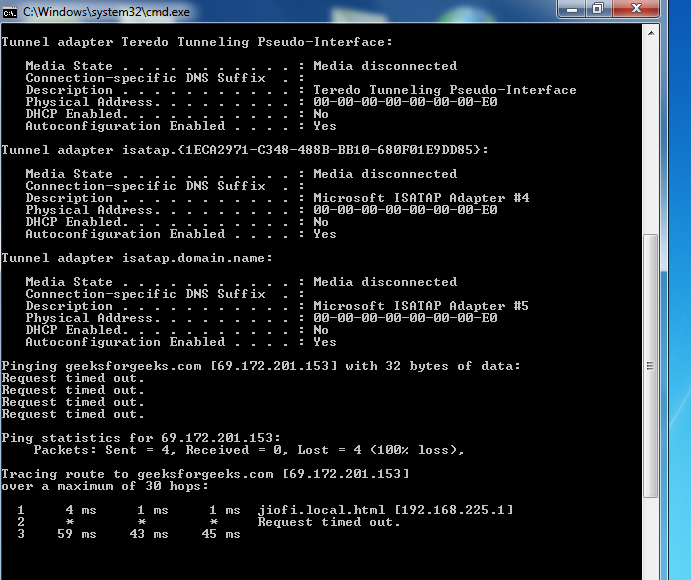
This script gives information about the current network and some network packet information. ipconfig /all helps to view the network information and ‘ping’ & ‘tracert’ to get each packet info. Learn about ping and traceroute here.
Last Updated :
29 Sep, 2022
Like Article
Save Article
Editor’s note: Adam Bertram originally wrote this article, and Reda Chouffani has expanded it.
Even though administrators can accomplish many tasks with ad hoc PowerShell commands, learning how to script brings your productivity to the next level.
Most administrators get introduced to PowerShell by working with its cmdlets from the command line. Once you’re familiar with executing commands and learn how to work with objects and the PowerShell pipeline, then it’s time to stitch these commands together into a script.
Going from entering commands to scripting isn’t difficult if you think about a script as a long-form command. Scripts execute one or more PowerShell commands together to accomplish a single task.
What are the basics of PowerShell scripting?
The purpose of PowerShell is to provide a command-line shell and scripting capabilities to automate and configure Microsoft’s platforms. This helps IT professionals with many of their administrative tasks.
The platform provides several capabilities that some of the administrative portals don’t offer. Scripting is also available to administrators to automate some of their administrative activities.
PowerShell scripting starts with opening some of the PowerShell terminals on the administrator’s machine. This can be done from a Windows machine or a Linux machine as well. Once the administrator launches the PowerShell tool, they can enter any of the desired commands they need.
The syntax used is specific to PowerShell and provides a way for administrators to interact and confirm or extract information from different systems based on the modules used. PowerShell also offers admins the ability to script their tasks to automate any repeatable processes or tasks they perform on the different systems.
This PowerShell scripting tutorial for beginners helps you make the transition from basic use to advanced functions to help with tasks like server deployments or assigning licenses to users.
How to write and create a PowerShell script
Let’s start with an example of querying Windows services from Windows Server. The Get-Service cmdlet queries all the services running on a local Windows computer from the PowerShell console.
If you want to find all of the stopped services, try to start them and add some logging capabilities, you need to create a PowerShell script.
In the example below, the PowerShell script contains more than one line, a construct known as a loop, as well as containing references to multiple commands:
$services = Get-Service | Where-Object {$_.Status -eq 'Stopped'}
foreach ($service in $services) {
Add-Content -Path 'C:\ScriptLog.log' -value "Attempting to start
$($_.DisplayName)…"
$service | Start-Service
}
You can build the script in the PowerShell Integrated Scripting Environment (ISE) editor that comes with Windows. Open the PowerShell ISE editor, copy the code and save it as Start-StoppedServices.ps1. All PowerShell scripts have a PS1 extension for Windows that prompts the PowerShell engine to execute the script.
As another example, in Windows 10 and Windows 11 machines, you can use PowerShell to retrieve some of the Windows Update logs to determine if a recent workstation issue is the result of a recent Windows update. To perform this task, run the following command in PowerShell:
Get-WindowsUpdateLog
Once the command completes its execution, a file is generated to provide all the details of all updates performed on the specific machine.
How to save a PowerShell script
Microsoft provides several ways to create PowerShell scripts, including the following:
- PowerShell ISE.
- Notepad.
- Notepad++.
- Visual Studio (Standard, Pro, Enterprise, Code).
Once the script is created, you can save it locally or to server storage using the PS1 extension. You can also use code repository platforms to ensure the versioning of your scripts.
How to execute a PowerShell Script
With your script saved in a single file, instead of typing out all that code, you can execute it as a single command by passing the entire script to PowerShell.
If you go back to the PowerShell console, you can run C:-StoppedServices.ps1 to execute all the code in that script. Creating scripts is similar to creating commands; it lets you piece together code and run it as a single unit.
You can also run PowerShell scripts from the cmd.exe command interpreter or from a batch file. You can launch a script from anywhere by invoking the PowerShell engine and passing a script to it.
In the following example, you use the File parameter to pass the script to PowerShell without opening the PowerShell console.
powershell -File C:\Start-StoppedServices.ps1
Best practices when designing PowerShell scripts
Once you build up a proficiency with PowerShell cmdlets and its scripting language, there are endless ways to solve problems with code. This scripting tutorial wouldn’t be complete without a few best practices that can help you construct proper scripts.
Simplify things, and think of your script as something that performs a single task or that solves a single problem. In our example, the script starts all the services that have stopped. Administrators can benefit from writing basic scripts that complete repetitive tasks, providing them with more time to work on more demanding tasks.
In addition, design scripts that require little maintenance. If your script only performs one task, you can eventually combine it with other scripts to create building blocks. Make scripts modular so you don’t have to change the code constantly. Parameters can help you further customize your scripts by defining variables to pass different values during script execution.
This should start you on your way from clicking through multiple menu options to complete a task to producing code that handles complex jobs in a flash.
To create a PowerShell script using the Notepad editor on Windows 10, use these steps:
- Open Start.
- Search for Notepad, and click the top result to open the app.
- Write a new or paste your script in the text file — for example: Write-Host «Congratulations! Your first script executed successfully»
How do I create a script?
You can create a new script in the following ways:
- Highlight commands from the Command History, right-click, and select Create Script.
- On the Home tab, click the New Script button.
- Use the edit function. For example, edit new_file_name creates (if the file does not exist) and opens the file new_file_name .
How do you write a script for a beginner?
Screenwriting 101: 7 Basic Steps to Writing a Screenplay
- Step 1: Craft a Logline. …
- Step 2: Write a Treatment. …
- Step 3: Develop Your Characters. …
- Step 4: Plot and Outline. …
- Step 5: Write a First Draft. …
- Step 6: Step Back and Take a Break. …
- Step 7: Rewrite.
How do you write a small script?
6 Tips for Writing Short Film Scripts That Connect
- Find a small, specific, significant idea you can tell well in a short script. …
- Craft a complex character with a small, significant want. …
- Create a pattern of external and internal change. …
- Start your story on page one. …
- Hit your scenes late and get out early. …
- Show don’t tell.
What is a Windows script?
A Windows Script File (WSF) is a file type used by the Microsoft Windows Script Host. It allows mixing the scripting languages JScript and VBScript within a single file, or other scripting languages such as Perl, Object REXX, Python, or Kixtart if installed by the user.
How to Write a Simple Batch File in Windows
What scripting language does Windows use?
By default, the primary scripting language is VBScript. You can use any scripting language for which you have a script engine as the primary scripting language.
How do I run a notepad script from Command Prompt?
Command Prompt
Open Start. Search for Command Prompt, right-click the top result, and select the Run as administrator option. Type the following command to run a Windows 10 batch file and press Enter: C:\PATH\TO\FOLDER\BATCH-NAME.
How do I write a script in word?
To start writing a script just hit alt+S and type your slug line. Then hit ENTER and you’ll automatically be in an Action paragraph. Type your description. When you hit ENTER again you will automatically be in another Action paragraph.
How do I save a script in Windows?
How to save a script
- On the File menu, click Save As. The Save As dialog box will appear.
- In the File name box, enter a name for the file.
- In the Save as type box, select a file type. For example, in the Save as type box, select ‘PowerShell Scripts ( *. ps1 )’.
- Click Save.
Can I code in Notepad?
You can use any programming language in Notepad. However, it needs to be consistent throughout the entire program. You can also use batch script to create batch files that are executed in the Windows Command Prompt. Press ↵ Enter after you complete each line of code.
How do you write a script format?
The basics of script formatting are as follows:
- 12-point Courier font size.
- 1.5 inch margin on the left of the page.
- 1 inch margin on the right of the page.
- 1 inch on the of the top and bottom of the page.
- Each page should have approximately 55 lines.
- The dialogue block starts 2.5 inches from the left side of the page.
How do I write a script in Windows 7?
About This Article
- Open PowerShell and make sure you choose «Run as administrator.»
- Click the File tab.
- Click New.
- Click the cursor in the script pane.
- Write your script.
- Click the File tab.
- Click Save.
Does Windows have a built in programming language?
The only programming language included is C#, but unless you want to write the code in Notepad and compile from a command prompt you’re going to need to install an IDE. There are several scripting languages available (Powershell, VBScript, and Windows batch).
What is the difference between programming and scripting?
Scripting languages are translated and cannot be converted into an executable file, whereas programming languages are generally compiled and created to executable the file. Scripting languages can combine existing modules or components, while programming languages are used to build applications from scratch.
What can Windows scripts do?
The advantage of the Windows Script File (. WSF) is that it allows multiple scripts («jobs») as well as a combination of scripting languages within a single file. WSH engines include various implementations for the Rexx, BASIC, Perl, Ruby, Tcl, PHP, JavaScript, Delphi, Python, XSLT, and other languages.
How do I create a Windows Script Host?
To activate or deactivate the Windows Script Host, type regedit.exe in the Run box and press Enter to open the Registry Editor. In the right panel, you will see Enable. If you see 0 entries, it means that Windows Script Host access is disabled on your Windows. Double Click and in Data Value type 1 to activate it.
How do I download a script file?
Downloading Script Files
- Download a single file. Click the file’s ellipsis (…) icon, and then select Download. …
- Download a folder of files. Click the folder’s ellipsis (…) icon, and then select Download Folder. …
- Download a page of files. Click the Select All check box and then click the Download icon.
Where can I write scripts?
Check out these options, pick what works for you, and start writing your screenplay right away.
- StudioBinder.
- Final Draft 10.
- Movie Magic Screenwriter.
- Celtx.
- WriterDuet.
- Highland.
- Fade In.
- Scrivener.
How do you write a 3 minute script?
Here’s all you need to write a short script of 3 minutes or more: A character with a problem (beginning), his or her opposed actions (middle), and how it ends (end). That’s it! Well, there is a little more to it than that.
How do you make a script on Google Docs?
Create a script
- In Docs, Sheets, Slides, or Forms, open a document, spreadsheet, presentation, or form.
- If you’re using Docs, Sheets, or Slides, at the top, click Tools. Script editor.
- If you’re using Forms, in the top-right corner, click More. Script editor.
- Create your script.
